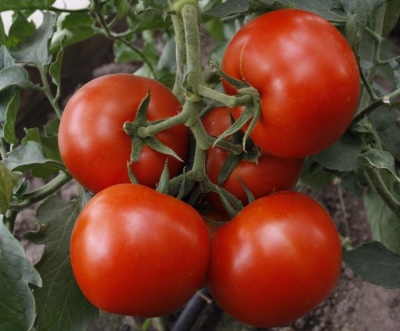
- Authors: Lukyanenko Anatoly Nikitovich, Dubinin Sergey Vladimirovich, Dubinina Irina Nikolaevna
- Year of approval: 2017
- Category: hybrid
- Growth type: indeterminate
- Appointment: fresh consumption, for juice
- Ripening period: mid-season
- Growing conditions: for open ground, for film greenhouses
- Marketability: Yes
- Transportability: Yes
- Bush size: tall
Tomato Alexander the Great is still little studied, since it was recently bred. However, he has already managed to win the respect of summer residents. Belongs to the category of hybrids, suitable for growing both in the open field and in the greenhouse.
Breeding history
The described hybrid variety was born several years ago thanks to the efforts of breeders of the Sedek agricultural firm. Its authors are: Dubinina Irina Nikolaevna, Lukyanenko Anatoly Nikitovich, Dubinin Sergey Vladimirovich. In 2017, Alexander the Great joined the ranks of the State Register of the Russian Federation.
Description of the variety
Nature has endowed the plants of this hybrid with high growth, the average height of the bush is two meters. Tomato leaves are rough to the touch, medium in size. Alexander the Great's foliage is lush, painted in dark green tones. Growth type is indeterminate.
The main qualities of the fruit
Tomatoes are flat-round in shape. The fruits can lie for a long time and do not crack, and all this is due to the very dense skin. The pulp is red-raspberry, contains many vitamins, trace elements and antioxidants. In an immature state, tomatoes are painted in a pale green color, as they ripen, the color changes and becomes bright scarlet, and a dark speck can be seen at the stalk. Tomatoes are very large, the average fruit size is 240 grams, in a particularly favorable environment - up to 500 grams.
Taste characteristics
Tomatoes taste very sweet. They are used mainly fresh, for cutting salads, making juices, cold snacks.
Ripening and fruiting
The ripening period of the vegetable is mid-season, the inflorescence includes 4-5 fruits (simple). The ripening stage lasts about 110-115 days. In greenhouses, the tomato is able to bear fruit until the October frost.
Yield
Providing sufficient watering and stable feeding in the open field, gardeners can expect to get 5.5-6 kilograms of vegetables from each bush. Greenhouse-grown tomatoes can yield approximately 14.4 kilograms per square meter. Ripe tomatoes must be picked every day and removed from the stalkless bush.
The timing of planting seedlings and planting in the ground
Alexander the Great is advised to prepare for the process of planting a tomato already in the fall. It is recommended to dig up the beds, destroy debris and weeds. And in the spring, feed the soil with a combination of leaves and manure. A couple of months before moving to open ground, you can start seedlings.

Growing tomato seedlings is an extremely important process, because it largely depends on whether the gardener will be able to harvest at all. All aspects must be taken into account, from seedbed preparation to planting in the ground.
Landing scheme
Young plants should be planted keeping a distance of about 40-50 centimeters between them. No more than three bushes of vegetables are placed on one square meter of soil. Otherwise, the tomatoes will interfere with each other with leaves. At the same stage, it is worth taking care of the support for the stalk garter.

Growing and care
Professionals give the following tips for caring for a tomato Alexander the Great:
watering twice a day - in the morning and in the evening;
the temperature of the water must be made to room temperature;
loosening the soil once every ten days (if necessary, once every 5-7 days);
weed control;
garter with pegs and twine;
eliminate shoots 1 time in 8-10 days;
feeding 1 time in 2 weeks.
Here you should pay attention to organic and mineral fertilizers, such as ammonium nitrate, garlic tincture, liquid mullein, mother liquor, phosphorus and calcium.
If vegetables are grown in a greenhouse, it is important to keep an eye on the temperature and humidity levels. The structure must be ventilated. In addition, drip irrigation can be organized there. Such a measure will not only save the strength of the gardener, but also allow to avoid tangible fluctuations in moisture in the ground. In addition, thanks to this method, water does not stay on the surface, which reduces the possibility of infectious and fungal diseases.




A plant needs different micronutrients at each stage of growth. All fertilizers can be divided into two groups: mineral and organic. Folk remedies are often used: iodine, yeast, bird droppings, eggshells.
It is important to observe the rate and period of feeding. This also applies to folk remedies and organic fertilizers.
Disease and pest resistance
Tomato Alexander the Great is invulnerable to the threat of verticillus and fusarium wilting, tobacco mosaic virus, cladosporium disease. However, do not forget about preventive measures. For example, spraying with garlic water or ash solution gives a good effect.


Resistant to adverse weather conditions
Tomato Alexander the Great can hardly endure hot weather and drought, is capricious in relation to the quality of the soil, therefore, it is necessary to apply fertilizers in a timely manner.
Growing regions
The geography of growing the hybrid is wide - it is the Central region, the Far East, Western and Eastern Siberia, northwest Russia, the Urals, the Middle, Lower Volga and other areas.
Review overview
Due to the fact that the Alexander the Great variety is quite young, there are few reviews about it, and they are contradictory. Some gardeners treat it warmly, focusing on excellent taste and a good harvest, the collection of which lasts until the October frosts. Others recognized the tomatoes as tasteless, not juicy enough, and the yield low.

























































































